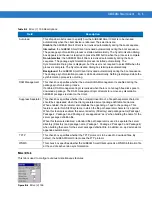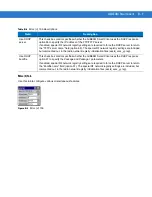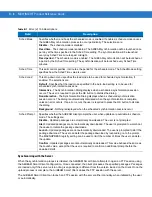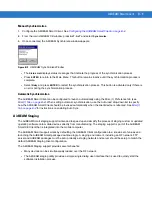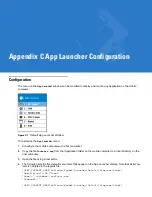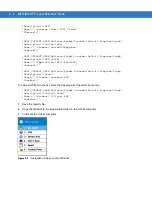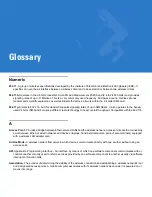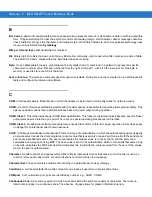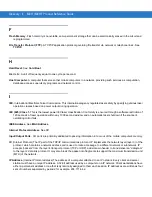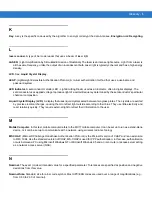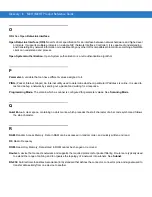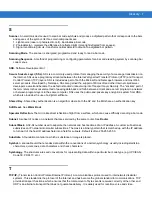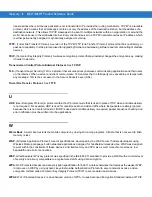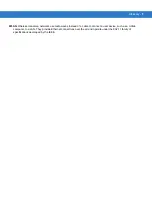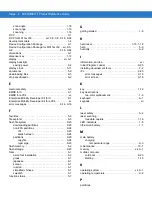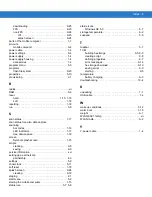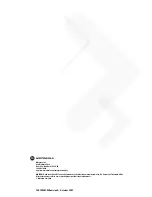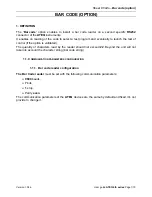
Glossary - 7
S
Scanner.
An electronic device used to scan bar code symbols and produce a digitized pattern that corresponds to the bars
and spaces of the symbol. Its three main components are:
1. Light source (laser or photoelectric cell) - illuminates a bar code.
2. Photodetector - registers the difference in reflected light (more light reflected from spaces).
3. Signal conditioning circuit - transforms optical detector output into a digitized bar pattern.
Scanning Mode.
The scanner is energized, programmed and ready to read a bar code.
Scanning Sequence.
A method of programming or configuring parameters for a bar code reading system by scanning bar
code menus.
SDK.
Software Development Kit
Secure Sockets Layer (SSL).
SSL is a commonly-used protocol for managing the security of a message transmission on
the Internet. SSL uses a program layer located between the Internet's Hypertext Transfer Protocol (HTTP) and Transport
Control Protocol (TCP) layers. SSL is included as part of both the Microsoft and Netscape browsers and most Web
server products. Developed by Netscape, SSL also gained the support of Microsoft and other Internet client/server
developers as well and became the de facto standard until evolving into Transport Layer Security. The “sockets” part of
the term refers to the sockets method of passing data back and forth between a client and a server program in a network
or between program layers in the same computer. SSL uses the public-and-private key encryption system from RSA,
which also includes the use of a digital certificate.
Shared Key.
Shared Key authentication is an algorithm where both the AP and the MU share an authentication key.
Soft Reset.
See
Warm Boot
.
Specular Reflection.
The mirror-like direct reflection of light from a surface, which can cause difficulty decoding a bar code.
Subnet.
A subset of nodes on a network that are serviced by the same router. See
Router
.
Subnet Mask.
A 32-bit number used to separate the network and host sections of an IP address. A custom subnet mask
subdivides an IP network into smaller subsections. The mask is a binary pattern that is matched up with the IP address
to turn part of the host ID address field into a field for subnets. Default is often 255.255.255.0.
Substrate.
A foundation material on which a substance or image is placed.
Symbol.
A scannable unit that encodes data within the conventions of a certain symbology, usually including start/stop
characters, quiet zones, data characters and check characters.
Symbology.
The structural rules and conventions for representing data within a particular bar code type (e.g. UPC/EAN,
Code 39, PDF417, etc.).
T
TCP/IP.
(Transmission Control Protocol/Internet Protocol) A communications protocol used to internetwork dissimilar
systems. This standard is the protocol of the Internet and has become the global standard for communications. TCP
provides transport functions, which ensures that the total amount of bytes sent is received correctly at the other end.
UDP is an alternate transport that does not guarantee delivery. It is widely used for real-time voice and video
Summary of Contents for MC17
Page 1: ...MC17 MC17T Product Reference Guide ...
Page 2: ......
Page 3: ...MC17 MC17T Product Reference Guide 72E 100467 03 Rev A October 2008 ...
Page 6: ...iv MC17 MC17T Product Reference Guide ...
Page 12: ...x MC17 MC17T Product Reference Guide ...
Page 38: ...1 20 MC17 MC17T Product Reference Guide ...
Page 60: ...3 6 MC17 MC17T Product Reference Guide ...
Page 66: ...4 6 MC17 MC17T Product Reference Guide ...
Page 96: ...8 12 MC17 MC17T Product Reference Guide ...
Page 122: ...9 26 MC17 MC17T Product Reference Guide ...
Page 130: ...10 8 MC17 MC17T Product Reference Guide ...
Page 146: ...B 10 MC17 MC17T Product Reference Guide ...
Page 158: ...Glossary 10 MC17 MC17T Product Reference Guide ...
Page 162: ...Index 4 MC17 MC17T Product Reference Guide ...
Page 163: ......

